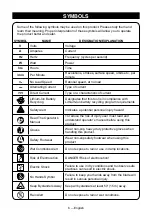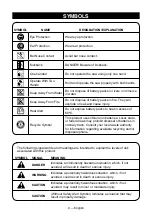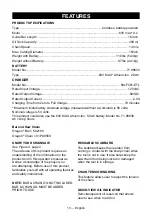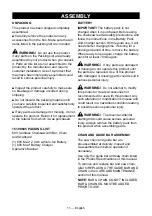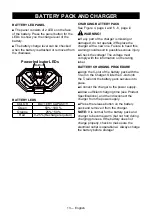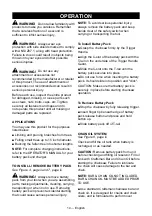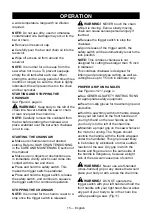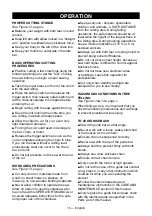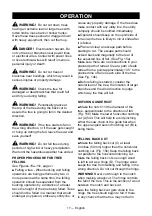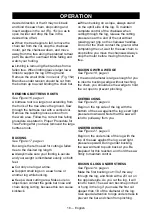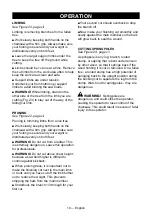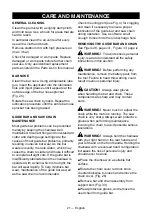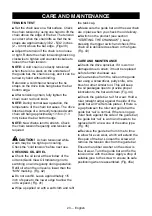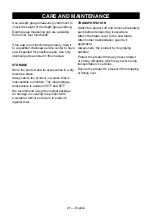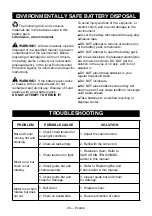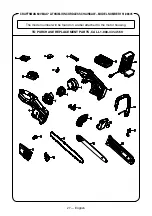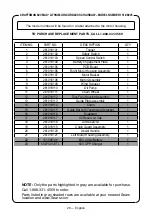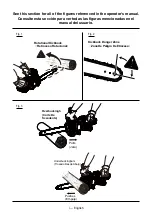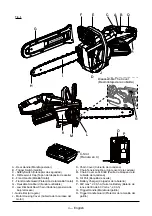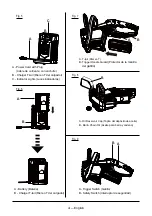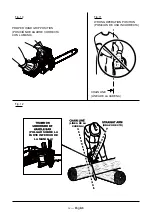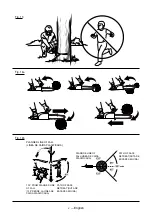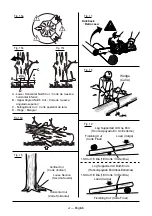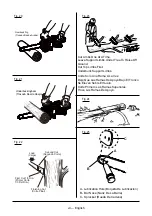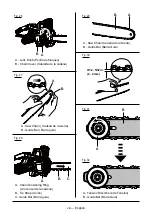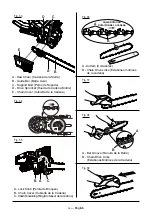
22 ― English
CARE AND MAINTENANCE
WARNING!
Keep all parts of the body
away from the chainsaw when the chainsaw
is operating. Before you start the chainsaw,
make sure the chainsaw is not contacting
anything.
A moment of inattention while operating
chainsaws may cause entanglement of your
clothing or body with the saw chain.
■ Use only a guide bar and saw chain as
listed in the Product Specifications of this
manual.
■ Lay the saw chain into the groove of the bar
with the cutting edges of the chain pointing in
the rotational direction shown on the bar.
(Fig. 27)
■ Ensure that the guide bar tension disc is
adjusted to the outermost position away from
the bar; turn the disc counterclockwise if
required. (Figs. 31-32)
■ Lay the saw chain around the drive
sprocket, and lay the guide bar against the
WARNING!
Always use a saw chain
designated as “low-kickback” or a saw chain
which meets the low-kickback requirements!
A standard saw chain (a chain which does
not have the kickback reducing guard links)
should only be used by an experienced
professional operator! Nevertheless, a low-
kickback saw chain does not completely
eliminated kickback! A low-kickback or “safety”
chain should never be regarded as complete
protection against injury! Therefore always
use a low-kickback saw chain in conjunction
with other kickback protection devices such
as the front hand guard!
DANGER!
Never start the motor
before installing the guide bar, chain, chain
cover, and chain cover lock knob. Without
all these parts in place, the clutch can fly off
or explode, exposing the user to possible
serious injury.
REPLACING THE GUIDE BAR AND CHAIN
See Figures 26-39, page viii-x
saw body so that the support bolt protrudes
through the hole in the guide bar tension disc.
(Figs. 33-34)
■ Replace the chain cover and slightly tighten
the red lock knob by rotating it clockwise. (Fig.
35). Do not tighten the lock knob completely;
saw chain tensioning is required first.
Proceed to SAW CHAIN TENSIONING
section.
■ After tensioning chain, fully tighten the
chain cover red lock knob.
SAW CHAIN TENSIONING
■ The chain is correctly tensioned when there
is no sag on the underside of the guide bar,
and when the chain is snug it can be turned
by hand without binding. If the chain is too
tight, it will not rotate.
■ Upon initial operation, new chains can
lengthen considerably. This is normal during
the break-in period and the interval between
future adjustments will soon increase.
1.To tension chain, first set the chainsaw on a
suitable flat surface.
2.Turn the chain tensioning black ring
clockwise until the chain tie straps are just
touching the bottom edge of the guide bar.
(Fig. 28)
NOTE:
The tension is correct when you
can lift the chain so that the tie straps are
approximately 3/32 - 5/32 inches (2 - 4
mm) above the bar edge. (Fig. 30)
3.After tensioning chain, fully tighten the
chain cover red lock knob.
■ Always check the saw chain tension before
use and regularly during use (approximately
every five cuts). See TENSION TEST section.
WARNING!
Never touch or adjust the
chain while the motor is running. The saw
chain is very sharp. Always wear protective
gloves when performing maintenance
involving the chain.

